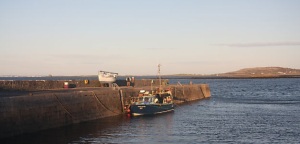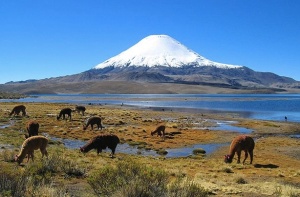Ballyvaughan Regatta – 1874
Corcomroe Abbey – 1929
W.S.O’Brien – Corcomroe – 1857
Connaught Telegraph 14th October, 1857 p.3 (abridged)
 On Monday, W.S.O’Brien Esq., arrived in Ballyvaughan from St. Catherine’s and drove on to see the ruins of the Abbey of Corcomroe in which lies a stone figure of one Connor O’Brien, a monk in the monastery about 600 years ago. After Mr. O’Brien returned in the evening, he proceeded to Lisonaid. A number of people lighted tar barrels and the unusual accompaniment was presented of a canoe or currough on fire to welcome him to his native county. Mr. O’Brien came out, and having briefly thanked the people for their reception of him the crowd dispersed and returned homewards, cheering so lustily that the distant sounds might be heard through the valley of Gleneraga, and even to the old Castle of Glenenagh.
On Monday, W.S.O’Brien Esq., arrived in Ballyvaughan from St. Catherine’s and drove on to see the ruins of the Abbey of Corcomroe in which lies a stone figure of one Connor O’Brien, a monk in the monastery about 600 years ago. After Mr. O’Brien returned in the evening, he proceeded to Lisonaid. A number of people lighted tar barrels and the unusual accompaniment was presented of a canoe or currough on fire to welcome him to his native county. Mr. O’Brien came out, and having briefly thanked the people for their reception of him the crowd dispersed and returned homewards, cheering so lustily that the distant sounds might be heard through the valley of Gleneraga, and even to the old Castle of Glenenagh.
Munster news.
——————–
Ballyvaughan Regatta
Tuam Herald 26th September, 1874 p.2
 The Ballyvaughan Regatta came off on Wednesday, at the village of Ballyvaughan, situate in the county Clare, and about eight miles from Galway across the bay. It was conducted under the patronage of the members of Parliament for Clare and the local gentry. The weather was most propitious, the day being exceedingly fine, and, by the way, was complained of by the ladies as being oppressive.
The Ballyvaughan Regatta came off on Wednesday, at the village of Ballyvaughan, situate in the county Clare, and about eight miles from Galway across the bay. It was conducted under the patronage of the members of Parliament for Clare and the local gentry. The weather was most propitious, the day being exceedingly fine, and, by the way, was complained of by the ladies as being oppressive.
The number of spectators was very large, and not alone were the lovers of aquatics in Clare afforded an opportunity of enjoying themselves, but so also were the people of Galway, as the splendid little vessel, the Citie of the Tribes, gave an excursion trip from Galway at eleven O’clock, by permission of the directors, thus affording as enjoyable a day’s amusement as could be wished for, and one of the best your correspondent has enjoyed for some time. The sports consisted of seven races and were exceedingly contested and most creditably conducted.
————————-
Michael Lynch – Omaha, Chile, Scotland, Ballyvaughan – 1904
The Omaha Daily Bee; 31st May, 1904 p12. (abridged)
 After spending more than a year visiting every country on the globe with the exception of China, Michael Lynch, a young blacksmith and a brother to Omaha City Gas Inspector John C. Lynch, met his mother in the little town of Ballyvaughan, Co. Clare, Ireland.
After spending more than a year visiting every country on the globe with the exception of China, Michael Lynch, a young blacksmith and a brother to Omaha City Gas Inspector John C. Lynch, met his mother in the little town of Ballyvaughan, Co. Clare, Ireland.
Michael is but 20 years old and had established himself in the blacksmith business in Omaha after learning the trade. The wandering fever, however, seized him a year ago last March and he set out to see the world. His family heard from him only occasionally, once from Chile and next from Scotland.
His own mother, Mrs Lynch was returning to Ireland to visit her mother, a hale and hearty 91 years old. It was just after Mrs Lynch had started homeward from Omaha when John heard from Michael in Scotland. He replied to him immediately and advised him of his mother’s trip to County Clare. The lad succeeded in beating her to Ballyvaughan. The reunion was filled with happy surprise.
—————————–
Corcomroe Abbey – 1929
Connacht sentinel 20th August, 1929 p.2 (abridged)
Corcomroe Abbey is in Co. Clare. It is about four miles from Kinvara and five miles from Ballyvaughan. “Corcomroe” (in Irish, Corcomoruadh) means the descendants of Moruadh who is said to have been a son of Queen Maeve. Corcomroe Abbey is a Cistercian abbey. Like other Cistercian abbeys, it was dedicated to the Blessed Virgin and had a special name – “de petra fertile” (of the fertile rock) or “de petra saxo” (of the green rock). In his Ordnance Survey letters, O’Donovan states that according to local tradition it was founded by the son of Conor na Siudaine O’Brien on the spot where Conor was killed c. 1267 by Guaire O’Shaughnessy of Dun Guaire, near Kinvara. In his “Manuscript Materials of Ancient Irish History,” O’Curry states that it was founded by Conor na Siudaine O’Brien. Ware and Archdall are in doubt as to whether it was founded in 1200 by Conor’s father, Donogh Cairbrech O’Brien, or in 1194 by Conor’s grandfather, Donal Mor O’Brien. Other writers state that it was founded by Donal Mór O’Brien in 1182. It is, therefore, certain that the abbey was provided by the O’Briens, and it is probable that it was founded by Donogh Cairbrech O’Brien about 1200.
The following are the most important historical events connected with the abbey;
Soon after its foundation it established a branch at Kilshanry in County Clare. In 1249 it became subject to the abbey of Furness in Lancashire. Not far from it, at Sindaine, which, according to the Ordnance Survey maps, is near Newtown Castle, a battle was fought in 1267 between Conor na Sindaine O’Brien and his uncle, Donal Connachtrach O’Brien who was aided by the O’Connors and the O’Loughlins of Burren. Conor was killed; he was buried in the chancel of the abbey church, and his grave was covered by a stone effigy which is still in existence. In 1317 another battle was fought near the abbey between Murtagh O’Brien, the Chieftain of Thomond, and his cousin, Donogh O’Brien, who endeavoured to depose him and who was assisted by the English. Donogh and the English were defeated, and the bodies of Donogh and his followers were interred in the abbey church. In 1418 the abbot, who seems to have been a very distinguished man, became Bishop of Kilmacduagh. In 1544 the abbey was dissolved, its monks were banished, and its possessions were granted to Murrough, Earl of Thomond.

